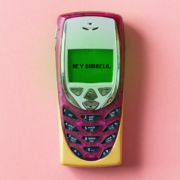I wish I didn’t have to tell you that our landlord was a six-foot-ten Israeli with a glass eye. But he was, so I do. Avi Sosna came to real estate in a classic Lower East Side manner, through the clothing business. With his posture, a mix of stoop and crouch, his cottony hair in two bulky wings combed aerodynamically backward, his overstarched shirts and comically wide suspenders, he cultivated the appearance of a prewar tailor-a shmatte man. He had never, strictly speaking, been one: Avi had come to New York in the seventies and worked his way up from clerk to manager to owner at a shop specializing in cut-rate leather, denim, and polyester. The shop, Leventhal’s Fine Fashion and Denim, was part of the barely functional tailor row that clung to the ground ?oors of Orchard Street tenements between Delancey and East Houston. Bad socks, three pairs for a dollar, lay stacked like apples on sidewalk tables; raincoats hung from the bottom rungs of ?re escapes. When Avi’s ascent began, it was still possible to get a decent bespoke suit made, or at least copied, in the back of some of these places. I don’t think Sosna himself had taken a needle to fabric even once. As for the eye, it was lost back in Israel, to an insurgent army of single-celled parasites.
The origin of Avi’s wealth, as reconstructed by me from his own gnomic utterances, a community-paper pro?le, and Bertha’s ceaseless chitchat, made for a tale either inspirational or cautionary. By 1982, Sosna had saved up enough to pry a 70 percent stake in the shop from the owner, Bernie Leventhal. He began his reign by sprucing up the storefront with a new sign. When Bernie, whose family had held the shop since 1911, saw it, he made a small noise and had to sit down right on the sidewalk. Sosna had excised nthal from Leventhal’s Fine Fashion and Denim. The name of the shop was now Leve’s Jeans, with the apostrophe brazenly mounting the skinny second e to create, for a casual glancer, an illusion of an i. The window displays ran blue with no-name denim.
The only impact the ruse had on the business was to induce Bernie to cash in his remaining stake and huff off. Less than a month after assuming full control of Leve’s Jeans, however, Sosna lost interest in denim. He noticed a trend his Orchard Street colleagues at best ignored and, at worst, consciously fought: a steady trickle of African American clientele from far uptown, interested almost exclusively in track suits. There seemed to be no explanation for this. Avi didn’t like to ask around, lest he give away a potential gold mine. He preferred to make his own observations, for which his one eye served him perfectly well. So he hopped on the A train and made his way to Harlem. Soon, the gangling, stooping Sosna, who still favored a Moshe Dayan-style eye patch back then, was hovering over a group of kids watching their fellows contort themselves on the asphalt to a busy boom-box beat. Periodically, a boy would jump into the circle in front of the dancers and recite a quatrain or two of boastful doggerel, apparently made up on the spot. The small crowd reacted with laughter and short, piercing hoots.
"Man, what’s with your eye?" asked a kid chewing on a toothpick.
"Amoebas ate it," said Avi. "Shhh."
In the distance, two teens, one of them a white girl, were covering a brick wall with thick, swollen-lettered, mock-3D calligraphy. Both wore military boots and army surplus gear; bandannas covered their noses and mouths. This was both an affectation and a necessity: the acrid, dizzying smell of spray paint wafted over the scene. Just about everyone else in the crowd-the dancers, the hooters, the nursery rhymers-wore a track suit.
Avi didn’t even pretend to understand what was going on, nor did he need to. He wasn’t there to have fun or to pass judgment. He saw everything he needed to see.
He rode back downtown on the stinking A train, its windows and seats covered with unreadable signs and designs like the ones he’d just seen the kids make. Avi felt like the A train looked: disgusting and soiled, his ulcer at full bore, his shirt drenched in August sweat, his insides knotted up in anger. One would have expected him to be exhilarated with the discovery, but instead he cursed himself for being too slow on the uptake. All those track suits-those kids had already bought them somewhere, and from someone other than him. He could very well be late to the party altogether. After all, how wide could this fad go, and how long would it hold? Not very.
Avi thought of the spray-paint teens and their bizarre color palette. They were clearly a part of the same scene. In his heart of hearts, where he still allowed himself to form illogical opinions, he found the dancing kids cute, if silly, but instinctively disliked the painters: their paramilitary getups, and especially the bandanna masks, reminded him of the Munich ’72 kidnappers. He also worried for the white girl. Where were her parents? Did they have any idea? This city, I’m telling you. This city.
Still, by the time the ?lthy train screeched into the cloaca of the Grand Street stop, Avi knew exactly what he was going to do. He called his supplier, who happened to be his brother-in-law Ye?m, and asked if it was possible to order track suits in neon colors.
"Neon? Avi, are you nuts?" exclaimed the brother-in-law.
"I am not nuts," said Avi. "Just a little one-time deal, long story."
"Are you selling to the shvarzers?"
"No, Ye?m, I am organizing a marathon team. Yes, I am selling to the shvarzers. What business is that of yours? Their money is just as green."
"Tfoo,"said Ye?m, but sent the suits as asked.
Within two years, Avi owned four Lower East Side clothing stores, all called Sosna’s, as well as a sneaker shop and Ye?m’s Wholesale Warehouse. He began to advertise, at ?rst exclusively on subway trains. His ads were designed with a lot of white negative space, daring graf?ti artists to bomb them; the tags then looked like a part of the original ad design. Jackbooted spray painters were now doing the hardest part of Avi’s job for him: they made his stores look street.
He learned all these shrapnel words-bomb, tag, street as an adjective-because he felt he needed to know the customer. He watched the movies his clients talked about, barely following the plots but making quick and precise sartorial notes. He noticed the uptown guests’ odd, persistent love for Scarface and, against his every fashion instinct, made sure to stock up on belted leather coats, which by all accounts had gone out with the seventies. The stock disappeared in a week. He started commissioning limited-edition custom jobs-tracksuits with crowns, graf?ti-style lettering, gold lamé, leopard prints-and charging inordinate amounts of money for them. Whatever he charged, his clients paid: many of them, he noticed, were visibly, if inexplicably, getting richer.
Another year or so later, a chesty reporter from The Village Voice, who said she was writing a series on graf?ti art ("Art?" Avi asked, confused), brought him a cassette by a group called Street Clik. "Listen," she said, pushing down the play button. The usual frantic clatter, to which Avi had grown accustomed, barrelled forth from the speakers.
SOS, brother need a ?x, new kicks,
Paging LES, A-Dog playing new tricks,
Sneaking out in new sneaks slicker than Slick Rick,
Run like the Rev, eclectic triptych, Apocalyptic, cut the diatribe,
The cut tribe’s all right with the Street Clik.
"I don’t understand," said Avi.
"A-Dog is you," said the reporter. "The rapper says he needs new sneakers, so he calls you on the Lower East Side. S-O-S is also a play on your store’s name, Sosna’s. It’s basically an unprompted commercial for your store. I’ve never seen anything like this."
Avi didn’t say a word, just blinked very fast with his healthy eye.
"But it goes farther than that," the Voice girl continued. "‘The cut tribe’s all right with the Street Clik.’ That’s a kind of compliment to the Jews. So you’re actually playing an important part in the cultural dialogue. It’s very unusual for a rap group to-"
"Are they popular?" interrupted Avi.
From that moment on, making money became almost too easy. Sosna didn’t like paying rent-money down the toilet!- so he set a new goal for himself: to buy the six buildings in which his businesses were located. Miraculously, as soon as he accomplished this, in the mid-1990s, the real estate prices in the neighborhood began to climb. Before he knew it, Avi owned vast stretches of the Lower East Side, ?nancing each new purchase with the equity on the previous one (dipping only into the amassed surplus value, never the original investment). It took him ?fteen years to buy the ?rst six buildings-and eighteen months to buy twenty-two more. Sosna feasted on the remains of the Orchard Street tailor row, gobbling up the brick husks that used to hold J. Schachter’s bed shop, Bernstein’s kosher deli, Grand dairy restaurant, Penchina textile company. One by one, the empty storefronts ?lled up with new businesses-whip-and-ball-gag "novelty" shops, bars that booked bands playing detuned guitars extremely loud or barely at all, boutiques that sold paint- splattered holey T-shirts. Somewhere along the line, Avi unloaded the clothing stores on Ye?m, without a twinge of regret or nostalgia. He barely noticed doing it. Ye?m ran every one into the ground within a year, becoming Avi’s biggest deadbeat lessee. Avi left him to squirm on the hook: let the sister see that the asshole was no good for her.
Excerpted from GROUND UP, by Michael Idov, published this month by Farrar, Straus and Giroux, LLC. Copyright © 2009 by Michael Idov. All rights reserved.







Wow, you seem to be very knowledgable about this kind of topics.~`*-.
Remarkable post! Chatting about how taken pleasure in the exact examining. I’m hoping to see significantly more from your website. It looks you might have very good knowledge combined with perception. My corporation is very much fulfilled with this particular tips.
Good day” i am doing research right now and your blog really helped me”
This web site is usually a walk-through its the data you wished concerning this and didn’t know who to inquire about. Glimpse here, and you’ll undoubtedly discover it.